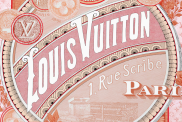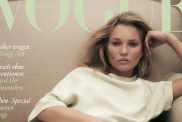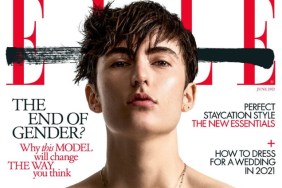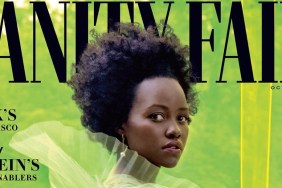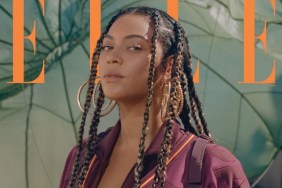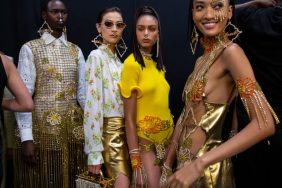As we wait with baited breath to see if the Spring 2017 runways reflect fashion’s growing proclivity towards diversity, the world of fashion editorial is giving us hope. This year, Elle UK is making history by featuring Amandla Stenberg, a bisexual and nonbinary actress and activist, Hari Nef, a transgender actress and model, and Kristen Stewart, who considers sexuality to be “fluid” and has been romantically linked to both men and women, on three of its five September covers (Zayn Malik and the work of embroiderer Claire Barrett are also featured).
The issue heralds a new age for Elle UK. “As the world changes, the world’s biggest-selling fashion magazine changes with it…” proclaims the glossy’s online counterpart. The magazine is kicking off the fashion season with “a new design, to mark a new era in fashion,” while celebrating “the rise of the rebel,” though “the rise of the self-realized individual,” might be a more apt description.

Image: Elle UK
In a 2015 interview with Nylon, Stewart expressed her reluctance to label her sexuality. “If you feel like you really want to define yourself, and you have the ability to articulate those parameters and that in itself defines you, then do it,” she said. “But I am an actress, man. I live in the f—— ambiguity of this life and I love it.” Unlike Stenberg and Nef, Stewart has not politicized her preference: “I don’t feel like it would be true for me to be like, ‘I’m coming out!’ No, I do a job,” she told the glossy. “Until I decide that I’m starting a foundation or that I have some perspective or opinion that other people should be receiving …I don’t. I’m just a kid making movies.” However, she has said that she feels in a few years the terms “gay” and “straight” will be obsolete, which is a pretty politicized statement in and of itself.
Seventeen-year-old Amandla has become a voice for young women of color, using her fame to spotlight the issues of race and sexuality and offer words of encouragement to those who, like her, have struggled against society’s precepts: “As someone who identifies as a black, bisexual woman, I’ve been through it and it hurts and it’s awkward and it’s uncomfortable,” she shared via Teen Vogue’s Snapchat in January. In March, Amandla told Interview that her rebel status is part and parcel of her identity. “I mean, unfortunately or not unfortunately, take it as you will, when you are a marginalized person or a woman of color and/or someone who’s a part of the LGBTQ community, your acts become politicized, just by being yourself,” she explained. “Because we’re not completely accepting of all different kinds of human beings. So that’s been an interesting dynamic for me to navigate. By being myself, I’m doing something political.”
Nef, meanwhile, as one of the few “marketable” transgender models, has enjoyed success in an industry that’s shut out many of her peers. She’s appeared in the hit Amazon series Transparent, starred in Mansur Gavriel’s latest campaign and walked the runways of Hood By Air and Eckhaus Latta, to name but a few of her accomplishments. In a 2015 interview with Vogue, the actress/performance artist/writer/model expressed her frustration with the fashion’s trans fetish: “I don’t think fashion is interested in trans issues. I can’t think of many fashion institutions or artists who have addressed ‘trans issues’ by name, can you? How many openly transpeople are getting major work in the industry—models, designers, photographers? Can you count them on more than one hand? Fashion is having a moment with trans aesthetics, not trans issues.”
She continued, “Trans aesthetics are powerful. People know when they’re looking at something that conflates masculinity and femininity, or blurs the lines in between. Trans aesthetics are also taboo, so historically they’ve been scarce. I don’t want to name names, but even fashion’s most notorious provocateurs have rarely operated outside of a cisgender milieu in terms of casting, collaborations, clothing specifications, etc. Trans aesthetics feel new. Not many have ‘gone there,’ you know? This idea, of course, is ludicrous, as transfolks have been around forever, but I’m happy to see trans aesthetics take root within an industry that thrives on its power to define what or who is beautiful and aspirational.”
well! here’s @elleuk september 2016! i’m grateful and shook! pre-order my cover here: https://t.co/bHEqgh7ev5 pic.twitter.com/C01BvnxRco
— hari nef (@harinef) July 1, 2016
In response to her Elle UK cover, Nef tweeted: “I’m grateful and shook!” Hopefully, fashion’s new era is one in which LGBTQ issues continue to be addressed in a real way and other brands demonstrate a similar commitment to elevating truly aspirational, once marginalized figures.
UPDATE: This article has been amended to include Kristen Stewart amongst the LGBTQ cover stars.
[ via Mic ]
